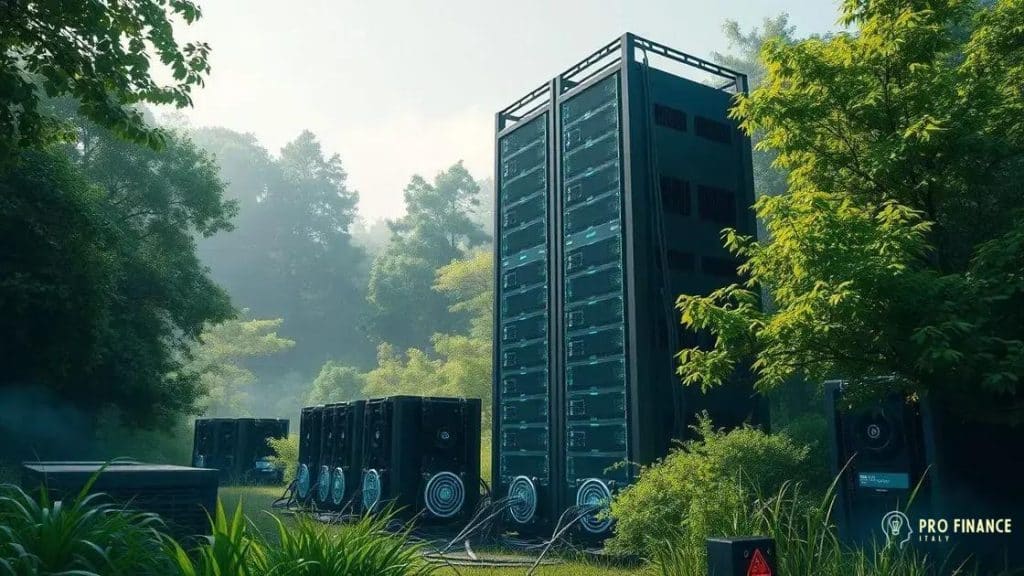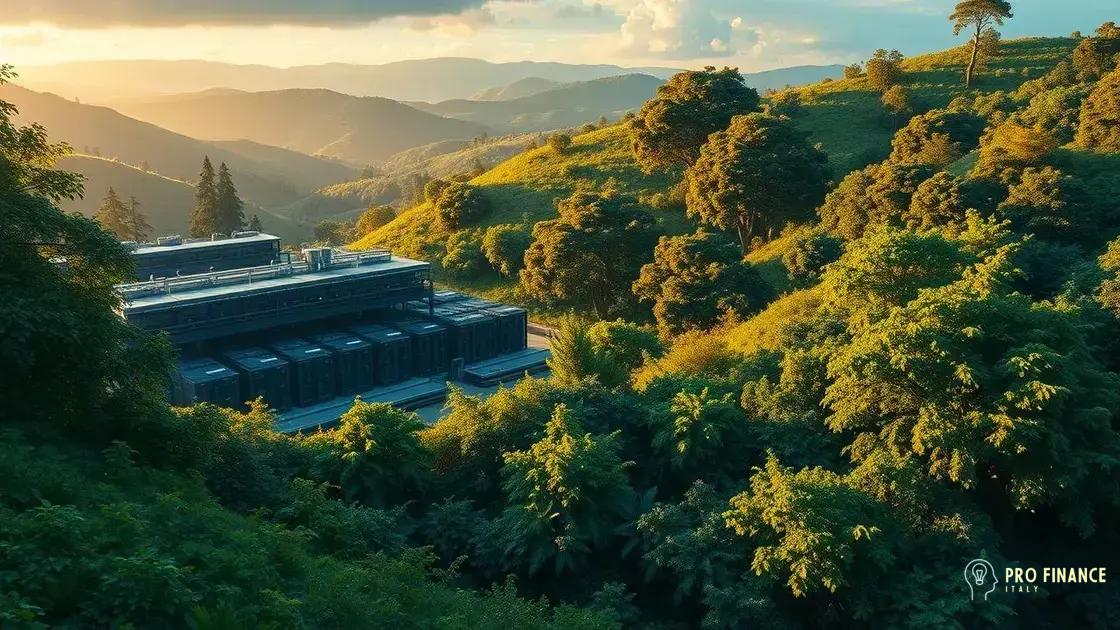Cryptocurrency mining and its environmental impact explained

Cryptocurrency mining has significant environmental impacts due to high energy consumption, but adopting sustainable practices and renewable energy sources can mitigate these effects and promote a greener future for the industry.
Cryptocurrency mining and its environmental impact have become hot topics as more people question the sustainability of this growing industry. Have you thought about how it affects our planet?
Understanding cryptocurrency mining
Understanding cryptocurrency mining is essential in grasping how digital currencies operate. This process involves verifying transactions and adding them to a blockchain, which is a public ledger.
The miners utilize powerful computers to solve complex mathematical problems. By doing so, they secure the network and receive cryptocurrency as a reward. This mining process not only supports the network but also releases new coins into circulation, making it an essential element of the cryptocurrency ecosystem.
How Mining Works
When a transaction is made with cryptocurrency, it is grouped with others into a block. Miners compete to verify this block by solving a puzzle. The first to solve it gets to add the block to the blockchain. This system ensures security and integrity.
Why Miners Matter
Without miners, the entire cryptocurrency system would collapse. They maintain the network’s functionality and protect it from attacks. Ultimately, miners are incentivized, as their work is rewarded with digital coins.
- Miners confirm transactions to ensure they are valid.
- They secure the blockchain from malicious attacks.
- The competition among miners helps decentralize the network.
However, this process requires significant energy and resources, raising concerns about the environmental impact.
Many miners use renewable energy sources to offset their electricity usage. This step is crucial as the demand for power in mining operations continues to grow. These efforts highlight a shift towards embracing sustainability within the cryptocurrency space.
Environmental consequences of mining

The environmental consequences of mining cryptocurrencies are a growing concern. As more individuals engage in mining, the impact on our planet becomes clearer. Mining requires a vast amount of energy, and this energy often comes from non-renewable sources.
This high energy consumption leads to increased carbon emissions, contributing to climate change. The process not only affects global temperatures but also damages local ecosystems surrounding mining operations.
Resource Consumption
Mining cryptocurrencies can use more electricity than entire countries. This resource consumption raises critical questions about sustainability. Miners often rely on fossil fuels, which further exacerbates the environmental problem.
- Coin mining facilities can consume enormous amounts of water.
- Mining operations may lead to habitat destruction.
- Noise pollution from mining equipment can disturb local wildlife.
The extraction of metals used in mining hardware also poses a dilemma. Mining for components like copper and lithium can lead to pollution and degradation of natural habitats.
Efforts are being made to mitigate these effects. Some miners are transitioning to renewable energy sources, such as solar and wind power. By doing so, they aim to lessen the overall carbon footprint of their operations.
Despite these efforts, the sheer scale of cryptocurrency mining still raises alarm. Governments and environmental organizations are pushing for regulations to reduce energy use and promote sustainable practices.
Comparing energy consumption with traditional banking
When we talk about energy consumption in the financial world, comparing cryptocurrency mining to traditional banking reveals surprising facts. Both systems require significant energy, but in very different ways.
Traditional banking primarily consumes energy through its infrastructure. Banks operate numerous branches, server farms, and ATMs. Each of these requires electricity for lighting, heating, and cooling systems. In contrast, cryptocurrency mining relies heavily on powerful computers solving complex algorithms.
Energy Use in Traditional Banking
Estimates show that traditional banks use substantial energy resources. This includes:
- Powering physical branches and their utilities.
- Maintaining data centers that process transactions.
- Operating ATMs, which consume energy over time.
Interestingly, while traditional banking has a large energy footprint, it often benefits from established, energy-efficient systems.
Energy Use in Cryptocurrency Mining
On the other hand, cryptocurrency mining is notorious for its energy demands. Miners need to run multiple high-performance computers continuously. They compete to solve mathematical puzzles, resulting in substantial electricity usage. This leads to concerns about the sources of this energy.
Some findings suggest that the energy consumption of mining exceeds that of some small countries. This heavy reliance on electricity can often come from non-renewable sources, driving up carbon emissions.
Both systems have room for improvement. As awareness of climate change grows, banks and cryptocurrency operations are looking for ways to enhance efficiency and minimize their impact on the environment. Innovations can help reduce energy use and transition to greener practices in both fields.
Innovations to reduce mining impact

Innovations aimed at reducing the impact of cryptocurrency mining are essential for a more sustainable future. As the cryptocurrency industry grows, so does the demand for solutions that lessen environmental footprints.
Many companies are exploring energy-efficient mining techniques. For example, miners are looking into using renewable energy sources. This shift can significantly reduce carbon emissions associated with mining.
Utilizing Renewable Energy
Mining operations powered by renewable energy are becoming more common. They harness resources such as:
- Solar energy, which is abundant in many areas.
- Wind energy, often generated in open spaces.
- Hydroelectric power, utilized in regions with access to water.
These sources provide cleaner alternatives to fossil fuels, making mining less harmful to the environment.
Energy Efficiency Technologies
Investing in advanced technologies can also increase energy efficiency. Miners can use specialized hardware designed to consume less power. As technology improves, new mining rigs become available, offering better performance with lower energy demands.
Moreover, some mining operations are incorporating artificial intelligence. AI can optimize the mining process, ensuring that machines run only when energy costs are low. This approach reduces operational costs and environmental impacts, making mining more sustainable.
Additionally, improving the cooling systems in mining facilities helps reduce energy consumption. Efficient cooling methods can prevent overheating while using less electricity, which lessens the overall energy burden on the power grid.
Future of sustainable mining practices
The future of sustainable mining practices is bright, as more companies recognize the need to balance profitability with environmental care. As the cryptocurrency landscape evolves, so do the methods for mining coins in eco-friendly ways.
Innovations in technology allow for significant improvements. Many miners are shifting toward energy sources that are renewable. Wind, solar, and hydroelectric power are becoming staples in mining operations, helping to reduce reliance on fossil fuels.
Emerging Technologies
New technologies are working to lower energy consumption further. Miners are adopting:
- Advanced cooling solutions that decrease temperature without using excess power.
- Efficient hardware that requires less electricity while maintaining high output.
- Smart power management systems to optimize energy use during non-peak periods.
By having these technologies, mining operations not only lower their environmental impact but can also save on operational costs.
Regulatory Trends
Governments are now pushing for tougher regulations on energy use in mining. They want to ensure that miners are using cleaner and more efficient energy sources. This regulatory environment will encourage sustainable practices and help protect the environment.
Furthermore, public awareness about climate change is driving demand for greener options. As consumers become more conscious of their ecological footprint, they are more likely to support cryptocurrencies that prioritize sustainability.
As the industry matures, collaborations between miners, tech companies, and environmental organizations will increase, leading to innovative strategies for sustainability. Working together can enhance transparency and promote responsible mining practices.
Sustainable practices are now at the forefront, as technology advances and regulations tighten. Miners are exploring renewable energy sources to reduce their impact on the environment. This shift not only helps combat climate change but also leads to cost savings.
The collaboration between miners, tech innovators, and regulators will shape a greener future for the cryptocurrency industry. As consumers demand more responsible options, the push for sustainability will only grow stronger.
FAQ – Frequently Asked Questions about Cryptocurrency Mining and Sustainability
What is cryptocurrency mining?
Cryptocurrency mining is the process of verifying transactions on a blockchain and adding them to a public ledger, which is essential for cryptocurrency networks.
How does mining impact the environment?
Mining consumes a lot of energy, often sourced from fossil fuels, leading to significant carbon emissions and environmental degradation.
What steps are miners taking to reduce their environmental impact?
Miners are increasingly using renewable energy sources, improving energy efficiency, and adopting advanced technologies to lessen their carbon footprint.
Why are sustainable mining practices important?
Sustainable mining practices help combat climate change, promote ecological balance, and meet consumer demand for more environmentally friendly cryptocurrency options.





